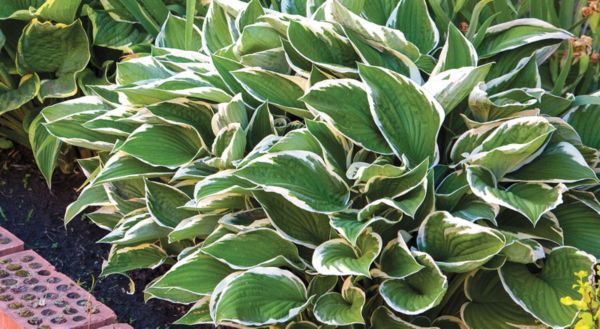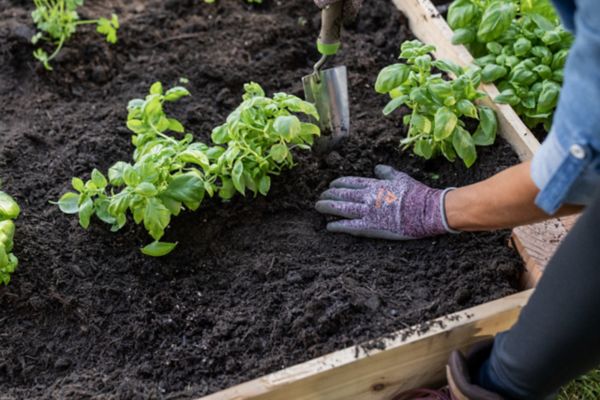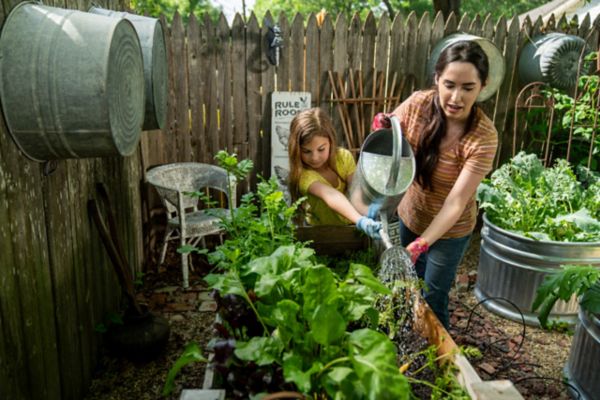How to Grow Romaine Lettuce
Authored by Leah Chester-Davis
Romaine lettuce is sometimes referred to as Cos lettuce for the Greek Island, Kos, where it originated. It gets the name romaine because it was highly favored in Rome. This lettuce is the type most often used in Caesar salads.
Romaine grows in upright, elongated, loose head forms. Individual leaves are long and a bit wavy with a distinctive rib running through the center to the tip. The end of the leaf is rounded and somewhat folded. The leaves are crisp, and the inside leaves become more delicate and paler green than the outer leaves. While the traditional form is a light to dark green, there are red varieties as well.
Like most lettuce, romaine is a cool-season crop and does best in the spring or fall, though it may be slower to bolt (send up flower stalks) than other types. Romaine contains Vitamins A and K. It also contains folic acid, potassium, and iron. It is a good source of fiber. Lettuce is low in calories.
The leaves are crisp and sturdy and hold up well in salads that contain other ingredients, giving salad a desirable crunch. The leaves are also used on sandwiches. Romaine is even popular as a grilled salad with slightly charred leaves that give it a smokiness. It is often served with a Caesar-style dressing or a light lemon vinaigrette and your choice of toppings. No matter how you serve it, to elevate flavors and freshness of your salads, sandwiches, and wraps, grow your own lettuce. There are many more options available to you and it is hard to beat that fresh-from-the-garden goodness!
About romaine lettuce
| Botanical name: | Lactuca sativa var. longifolia |
| Common name: | Lettuce |
| Plant type: | Annual |
| Size: | 6 to 24 inches tall, depending on variety |
| Sun exposure: | Full sun |
| Soil type: | Fertile |
| Soil pH: | 6 to 6.7 |
| Hardiness zones: | 2a to 11b |
| Average first frost: | Varies by region |
| Average last frost: | Varies by region |
| Container friendly: | Yes |
| Beginner friendly: | Yes |
Growing
Romaine likes full sun and rich, well-drained soil that has a pH of 6.0 to 6.7. The soil needs to be well worked so that it is loose and friable and contains plenty of organic matter for moisture retention. To find out your soil pH and receive helpful recommendations, pick up a soil test kit at your county Extension center. Most will have them available for free or a nominal fee. If possible, get your soil tested and work your soil in the fall so you will be prepared for early spring planting.
Lettuce is a cool-season crop and does not withstand heat well. It likes temperatures around 60 to 65 degrees F. It will withstand light frosts. In hot climates it may benefit from afternoon shade or from being interplanted with taller, later-maturing crops that allow the sun to reach it during early growth but shades it as the larger crop grows. This is also a way to take advantage of space in your garden.
While lettuce grows best in the cool seasons, if growing in the summer or warmer climates, a shade cloth can help protect it from the hot sun and high temperatures. To extend the growing season, Maryland Extension recommends row covers in the early spring to promote rapid growth and minimize slugs and pests, and again in the fall to extend production after frost.
Sow seeds directly into the garden or plant transplants. When sowing seeds directly into the garden, give lettuce a light watering to avoid dislodging the seeds.
To extend the growing season, Maryland Extension recommends row covers in the early spring to promote rapid growth and minimize slugs and pests, and again in the fall to extend production after frost.
Planting
When sowing seeds, sow them in a shallow manner, about 1/8- to 1/4-inch-deep and an inch apart in rows. Space rows 12 to 18 inches apart. When the plants have two to three true leaves, thin the plants to allow about 10 to 12 inches between plants. If growing mini varieties, space about 8 inches apart.
If planting transplants, acclimate them to the outdoors over a period of a few days before planting in the ground. When planting, space about 10 to 12 inches apart in rows. Succession planting, where you plant every week to two weeks for a month or so will allow the harvest to be extended over a few weeks.
Most varieties of romaine take about 70 days to mature. In the spring, plant as soon as you can work the soil. For a fall crop, plant in late summer. Consider the maturity date so you can time the harvest about the time of the average first frost. To determine this, find the average first frost in your region and count backwards 70 days or by the number of days to maturity specified for the variety you are growing. The mini varieties, such as ‘Little Gem’ or ‘Breen’ typically mature earlier, from 43 to 50 days. They have a crisp, sweet flavor and are suited for small spaces.
Romaine lettuce can be grown in containers though loose-leaf types are more commonly grown this way. To grow in a container, use a quality potting mix for vegetables. Make sure the container has a drainage hole and the container is about 12 inches in diameter and 12 inches deep or a long container that is 8 to 12 inches deep and 12 inches wide and long enough to hold more than one plant. Lettuce has a shallow root system. Take care when weeding or working around the plant.
Keep moisture levels even and don’t allow the soil to dry out. Water at the base of the plant or use drip irrigation. Any overhead watering should be done in the morning to allow time for the leaves to dry during the day. Water every four to five days as needed. If growing in containers, you may need to water more frequently. Lettuce will need 1 to 2 inches of water per week. Mulching around lettuce with straw can help suppress weeds and control moisture levels.
Fertilizing
- Follow soil test recommendations. If you don’t have a soil test but have amended the soil with aged manure you may not need to apply fertilizer.
- In the absence of a soil test, Utah State Extension recommends applying ¼ cup of a nitrogen-based fertilizer (21-0-0) per 10 foot of row four weeks after transplanting or at thinning to encourage rapid plant growth. Sidedress the lettuce, which means to apply the fertilizer to the side of the plants, not touching the leaves. Water well after applying.
- Avoid using weed and feed fertilizers on lettuce or any other vegetable plants.
Controlling Pests, Diseases and Other Problems
Generally, pests and diseases are not a problem. If slugs become a problem, remove the mulch around the plant. Keep the garden clean and remove any other potential hiding places for these pests. Use slug baits if needed. Scout for pests and diseases each week to address any problems early and to help avoid any issues.
- Aphids sometimes feed on the underside of leaves. Use a stream of water to dislodge or use an insecticidal soap. Follow label directions.
- Cutworms, flea beetles, and leafhoppers are other pests. Cutworms can cut young plants off at the base. Handpick off plants. Flea beetles chew small, round holes in the leaves. Leafhoppers feed on the plant juices, which can result in stunted, yellow plants. Insecticides may be needed. Follow label directions for use and recommended wait times before consuming.
- Foliage rots can be a problem in hot weather or wet seasons. The best control is to ensure good soil drainage and to keep the foliage dry by watering at the base of the plant or using drip irrigation or a soaker hose.
Sidedress the lettuce, which means to apply the fertilizer to the side of the plants, not touching the leaves. Water well after applying.
Harvesting and Storing
Young, tender, outer leaves can be picked as the plant grows. Regular picking, when the leaves are about 6 to 8 inches tall, gives you tasty, flavorful leaves, and keeps the plant producing. Pick the outer leaves frequently.
When the plant matures and as the temperatures warm the leaves may start to become bitter. Cut the entire head of lettuce off at the stem at the soil line.
Storing
Romaine lettuce will last several days in the refrigerator. Store in a plastic bag with a paper towel to absorb any moisture. Romaine should remain crisp if stored in the refrigerator. If it appears limp, plunge the leaves into ice water to help revive them.
Avoid storing lettuce with or near fruits that release ethylene gas. Apples, pears, and bananas release ethylene gas, which is a natural ripening agent. It can cause lettuce to turn brown.
Wash lettuce just before using in salads or on sandwiches.
Avoid storing lettuce with or near fruits that release ethylene gas. Apples, pears, and bananas release ethylene gas, which is a natural ripening agent. It can cause lettuce to turn brown.
Expert Tips
- Check with your local garden center or county Extension office for best varieties for your region and for best planting dates. While many lettuces are easy garden vegetables to grow, romaine can be a bit challenging in warm, Southern climates.
- Home-grown lettuce is delicious. Succession planting can help extend the harvest. In addition to romaine, use this growing guide for other loose leaf and head lettuces. A mix of lettuces provide variety to your salads.
- Lettuce seeds are tiny and it’s easy to seed too heavily. As the plants grow, thin them out if needed to give remaining plants plenty of room to grow. Any seedlings that are thinned out can be used in salads.
- Implement good cultural practices to reduce problems with insects and diseases. Work your soil well and amend with aged manure or compost. Make sure it is well-drained. Keep weeds in check. Space plants to give them room to grow and allow for good air circulation. Use drip irrigation or soaker hoses to water at the base of the plant.
Frequently asked questions
Why do the edges of my lettuce leaves turn brown?
This may be due to a fluctuation in soil moisture levels. Wet and dry periods can result in what is called tipburn.
Why is my lettuce bitter?
A lack of water and hot temperatures can cause bitterness. Keep the soil moisture levels even and plant early enough in the spring and late enough in the fall to take advantage of cooler temperatures. Utah Extension advises washing and storing the leaves in the refrigerator for a day or two to help remove some of the bitterness.
Lettuce seeds are tiny and it’s easy to seed too heavily. As the plants grow, thin them out if needed to give remaining plants plenty of room to grow. Any seedlings that are thinned out can be used in salads.





